|
We came to a bit of Bavaria in late August, 2001. We were told by our friend Sascha that we must visit Mittenwald, and eat in a wonderful restaurant in nearby Leutach. So we followed his advice and enjoyed our stay very much.
Bavaria is in the southeastern part of Germany, at the foothills of the Alps, near Austria and Switzerland. And it is the one place you will probably see men in lederhosen, women in traditional dress, and hear folk music regularly (oom-pah!).
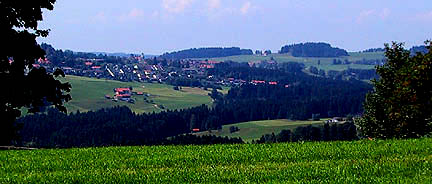 To get to Mittenwald, we traveled by Lake Constance, then took the ferry across the Bodensee, over the hills into Garmisch-Partenkirchen (home of the winter Olympics 1936). This is about as far as most Americans go as it is only about 100 kilometers from Munich. But of course, we didn’t come via Munich, we came through the mountains and enjoyed the wonderful roads with the other hundred or so bikers on a sunny Sunday afternoon. Naturally we were rewarded by the most gorgeous scenery one could imagine. Everywhere we turned there were luscious green valleys with a backdrop of mountains. Above is a view from one of the mountain passes. To get to Mittenwald, we traveled by Lake Constance, then took the ferry across the Bodensee, over the hills into Garmisch-Partenkirchen (home of the winter Olympics 1936). This is about as far as most Americans go as it is only about 100 kilometers from Munich. But of course, we didn’t come via Munich, we came through the mountains and enjoyed the wonderful roads with the other hundred or so bikers on a sunny Sunday afternoon. Naturally we were rewarded by the most gorgeous scenery one could imagine. Everywhere we turned there were luscious green valleys with a backdrop of mountains. Above is a view from one of the mountain passes.
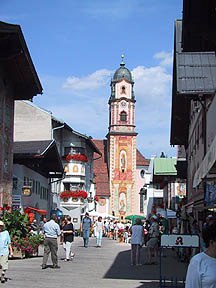 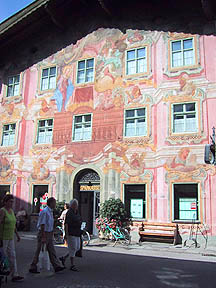 Mittenwald is another 20 km past Garmisch, also nestled at the base of the Alps, but much smaller, quieter, and less metropolitan. This is a town where the Germans go for holiday, as a base for sightseeing or hiking in the surrounding mountains. It is town full of beautifully painted buildings, each its own work of art (we just kept marveling at the cost for repainting!). At left is a view of the center of town, with the church tower at the center. At the right is the bank, in all its glorious detail. Not all the buildings are completely decorated as these, but most have at least a mural or decorated window frames. Mittenwald is another 20 km past Garmisch, also nestled at the base of the Alps, but much smaller, quieter, and less metropolitan. This is a town where the Germans go for holiday, as a base for sightseeing or hiking in the surrounding mountains. It is town full of beautifully painted buildings, each its own work of art (we just kept marveling at the cost for repainting!). At left is a view of the center of town, with the church tower at the center. At the right is the bank, in all its glorious detail. Not all the buildings are completely decorated as these, but most have at least a mural or decorated window frames.
Water runs down the middle of the main street in town, probably a reminder of the days when it was the sewer that ran down the street (thank goodness it is now much cleaner than that!). Of course this means you have to watch where you are walking as there are no railings to k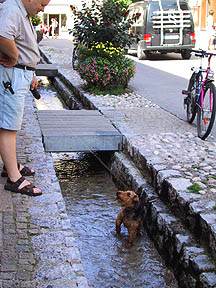 eep you out. We found at least one visitor was enjoying the water and did not want to get out! eep you out. We found at least one visitor was enjoying the water and did not want to get out!
We spent quite a bit of time walking around the town, window shopping and viewing the neighborhoods. In the shops you can get most any kind of traditional dress. The lederhosen and boiled wool jackets were exceptional, but we can’t imagine feeling comfortable wearing them anywhere else but here.
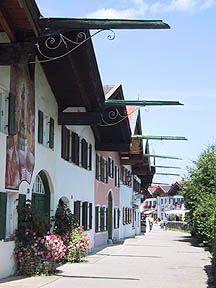 In the neighborhoods, we enjoyed the traditional architecture with lots of decorative wood in the shutters, balconies and eaves. Of course every window box and balcony was a billowing mass of brightly blooming geraniums and petunias, adding splashes of color to the pristine setting. One architectural oddity we noticed were the old-fashioned rain gutters that extended from 6 to 10 feet away from the buildings. Pictured at right is a series of them in town on a row of line houses. The pavement below is asphalt, except under the ends of the spouts where granite stones have been laid to take the brunt of the force from the falling water. This was certainly one way to divert the water away from the houses! In the neighborhoods, we enjoyed the traditional architecture with lots of decorative wood in the shutters, balconies and eaves. Of course every window box and balcony was a billowing mass of brightly blooming geraniums and petunias, adding splashes of color to the pristine setting. One architectural oddity we noticed were the old-fashioned rain gutters that extended from 6 to 10 feet away from the buildings. Pictured at right is a series of them in town on a row of line houses. The pavement below is asphalt, except under the ends of the spouts where granite stones have been laid to take the brunt of the force from the falling water. This was certainly one way to divert the water away from the houses!
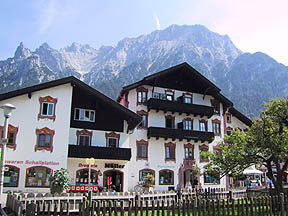 The town of Mittenwald lies in a valley with mountains to the east and the Alps to the west (the valley itself is at about 3500 feet). At left is a view of the Alps rising majestically above the local houses (the highest peak is 2628 meters). There is a cable car that will take you to the top if you desire, though we did not ride up. For the really adventurous sorts, you can ride up and hike down (or ski down in the winter). Although the town was nearly full of visitors in August when we were there, we are sure it is holiday haven in the winter ski season. The town of Mittenwald lies in a valley with mountains to the east and the Alps to the west (the valley itself is at about 3500 feet). At left is a view of the Alps rising majestically above the local houses (the highest peak is 2628 meters). There is a cable car that will take you to the top if you desire, though we did not ride up. For the really adventurous sorts, you can ride up and hike down (or ski down in the winter). Although the town was nearly full of visitors in August when we were there, we are sure it is holiday haven in the winter ski season.
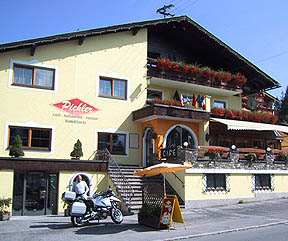 The Austrian border is just northeast of Mittenwald, and a short drive over the mountain will take you to the valley of Leutach. The valley is dotted with small villages full of guesthouses and really comes alive in the winter as the area is great for cross-country skiing. There is also one downhill area for those with a need for speed. In the village of Weisbach is a great little restaurant we were told had the best food in the world. While we can’t vouch for that (we haven’t yet tried everywhere in the world!), we can tell you that the pea soup and the garlic cream soup were fantastic and the trout menuire and the lake trout fillet were absolutely divine. Everything was fresh, wonderfully prepared, and artfully presented. But we’ll have to go back to try their desserts as we left no room for them. The restaurant is named Pichler and is pictured at right. The Austrian border is just northeast of Mittenwald, and a short drive over the mountain will take you to the valley of Leutach. The valley is dotted with small villages full of guesthouses and really comes alive in the winter as the area is great for cross-country skiing. There is also one downhill area for those with a need for speed. In the village of Weisbach is a great little restaurant we were told had the best food in the world. While we can’t vouch for that (we haven’t yet tried everywhere in the world!), we can tell you that the pea soup and the garlic cream soup were fantastic and the trout menuire and the lake trout fillet were absolutely divine. Everything was fresh, wonderfully prepared, and artfully presented. But we’ll have to go back to try their desserts as we left no room for them. The restaurant is named Pichler and is pictured at right.
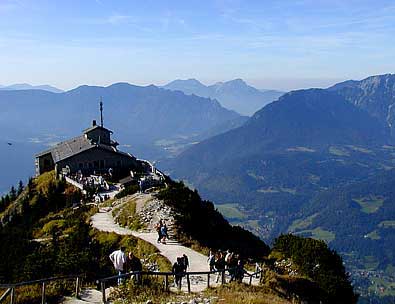 We returned to Bavaria in September, 2002 to visit Munich and and surrounding areas with our friend Nancy Haynes. The day we got to the Munich area, the weather was nice so we took the opportunity to drive to Obersalzberg to visit the Eagle’s Nest (left). It was a good thing we did so as we never had another clear day like this while we were there. An American couple provides excellent tours of the Obersalzberg and all the Nazi history associated with it. We were first driven around the area and shown where all the houses and building were (a few still exist while the others were destroyed by bombing). We returned to Bavaria in September, 2002 to visit Munich and and surrounding areas with our friend Nancy Haynes. The day we got to the Munich area, the weather was nice so we took the opportunity to drive to Obersalzberg to visit the Eagle’s Nest (left). It was a good thing we did so as we never had another clear day like this while we were there. An American couple provides excellent tours of the Obersalzberg and all the Nazi history associated with it. We were first driven around the area and shown where all the houses and building were (a few still exist while the others were destroyed by bombing).
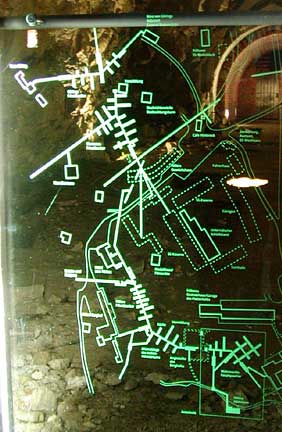 W e the n got a tou r of a section of the 6 km of tunnels built under these hills as a safe place of retreat, should it be needed (although they had living quarters in them, they never stayed there for any long period). A map of the tunnel network is shown at right, depicting the tunnels as well as their connection to the buildings above [in dotted lines]). It was interesting to note that there is a smaller section of tunnels at the top not connected to the lower, larger section. The smaller section was connected to Goering’s residence; Borman was in charge of the building of the tunnels and as he did not like or trust Goering, Borman never made the connection so that Goering would not have access to Hitler. Interesting dynamics within the Third Reich. W e the n got a tou r of a section of the 6 km of tunnels built under these hills as a safe place of retreat, should it be needed (although they had living quarters in them, they never stayed there for any long period). A map of the tunnel network is shown at right, depicting the tunnels as well as their connection to the buildings above [in dotted lines]). It was interesting to note that there is a smaller section of tunnels at the top not connected to the lower, larger section. The smaller section was connected to Goering’s residence; Borman was in charge of the building of the tunnels and as he did not like or trust Goering, Borman never made the connection so that Goering would not have access to Hitler. Interesting dynamics within the Third Reich.
And finally, we took the bus trip to the top where Hitler’s retreat (the Eagles Nest) was built (but he rarely went there; he was afraid of heights and enclosed spaces so didn’t like the tunnel and elevator ride to the top). Nevertheless, it provides provides fantastic views on clear days.
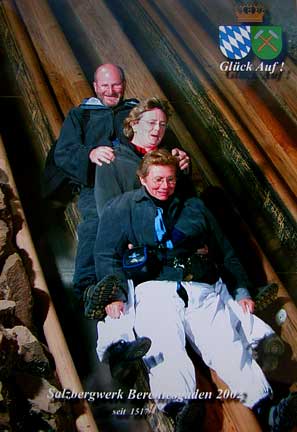 We visited the town of Berchtesgaden, near the Obersalzberg, enjoying a trip to the Salzbergwerk Berchtesgaden. This salt mine has been in operation since 1517 and continues to operate today. Most of the salt is extracted by brine. A deep shaft is drilled then the lower portion filled with fresh water. The salt dissolves, leaving a rocky residue in a now larger hole. The water at the top is removed - a brine containing the disolved salt. More water is added and salt continues to dissolve from the until the cavern is quite large in diameter. The resulting hole is continuously filled to the top and salt is leached from the ceiling. A huge cavern like this will supply brine for up to 30 years. On the tour, we were floated across one of the resulting lakes no longer being used for production. We visited the town of Berchtesgaden, near the Obersalzberg, enjoying a trip to the Salzbergwerk Berchtesgaden. This salt mine has been in operation since 1517 and continues to operate today. Most of the salt is extracted by brine. A deep shaft is drilled then the lower portion filled with fresh water. The salt dissolves, leaving a rocky residue in a now larger hole. The water at the top is removed - a brine containing the disolved salt. More water is added and salt continues to dissolve from the until the cavern is quite large in diameter. The resulting hole is continuously filled to the top and salt is leached from the ceiling. A huge cavern like this will supply brine for up to 30 years. On the tour, we were floated across one of the resulting lakes no longer being used for production.
Of course, one of the thrills of the tour is to slide down the wooden slides used to lower workers form one area to another. At left is the photo of Verna, Nancy, and Jim (wearing their 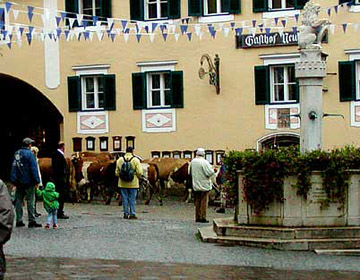 protective miner’s clothin g) as they take the plunge down the slide. Hey Verna, your fly is open! protective miner’s clothin g) as they take the plunge down the slide. Hey Verna, your fly is open!
We later went into town to walk around and window shop when we found a lovely cafe for an apple strudel and tea. Yum! As we were walking through town, we suddenly heard the clanking of the cow bells and they sounded really close - only because they were - the local farmer was leading his cows back to the barn right through town, much to the surprise of many. But it was obvious this was a regular event as the cows expertly marched up and down several steps in their path without missing a beat.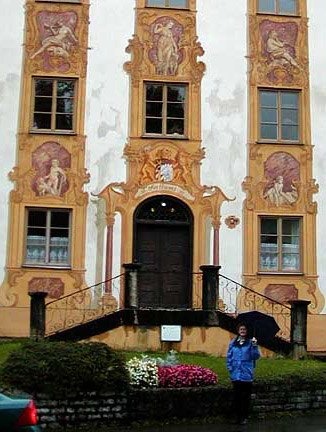
In the southwest corner of Bavaria is the New Schwanstein castle that was built by Mad King Ludwig (covered in our page of the Romantic Road) and nearby, the town of Oberammergau, sight of the Passion Play every 10 years. Although we missed the play by a couple of years, we did stop to stroll through the town and enjoy all of the beautifully painted houses. Many are painted with religious themes although several depict everyday life. Above, right is a particularly detailed one from 1753 that we liked (that’s our friend Nancy standing in the rain in front!). Did we mention that the weather was cold and raining? On a more whimsical note, there was an especially nice home depicting the tale of Red Riding hood (above, left).
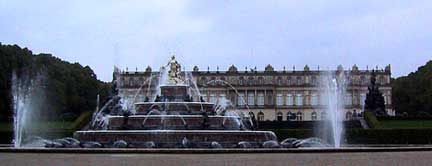 Between Munich and Berchtesgaden is Chiemsee Lake where Mad King Ludwig built yet another of his unfinished castles. This one, Herrenchiemsee, was modeled after Versailles and the King did his best to increase the grandeur and opulence, even if the overall size is smaller. Only 20 of the rooms were finished and there were no plans for the other 50 rooms, so they remained unfinished. He had only spent 9 days here before his untimely death, so even the finished rooms were never really lived in or used. The palace opened to the public shortly after his death in an attempt to regain some of the money spent on the palace (more than New Schwanstein and Linderhof combined). The view from the gardens is at left. Between Munich and Berchtesgaden is Chiemsee Lake where Mad King Ludwig built yet another of his unfinished castles. This one, Herrenchiemsee, was modeled after Versailles and the King did his best to increase the grandeur and opulence, even if the overall size is smaller. Only 20 of the rooms were finished and there were no plans for the other 50 rooms, so they remained unfinished. He had only spent 9 days here before his untimely death, so even the finished rooms were never really lived in or used. The palace opened to the public shortly after his death in an attempt to regain some of the money spent on the palace (more than New Schwanstein and Linderhof combined). The view from the gardens is at left.
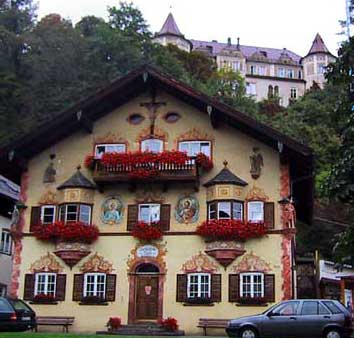 Returning from Herrenchiemsee, we took a slight detour to pass through the little town of Neubeuern, whose old town center was faithfully rebuilt after 2 disastrous fires in the late 1800s. The houses, church and town gates are covered with trompe-l’oeil paintings and the castle (built in the local historical style in 1904-08) sits on the hill above, overlooking the town. The old town is quite small, only a couple of blocks long, with a town gate at either end, each small enough to keep out the large tourist busses. One of the houses covered with paintings and embellished with geraniums appears at right. Returning from Herrenchiemsee, we took a slight detour to pass through the little town of Neubeuern, whose old town center was faithfully rebuilt after 2 disastrous fires in the late 1800s. The houses, church and town gates are covered with trompe-l’oeil paintings and the castle (built in the local historical style in 1904-08) sits on the hill above, overlooking the town. The old town is quite small, only a couple of blocks long, with a town gate at either end, each small enough to keep out the large tourist busses. One of the houses covered with paintings and embellished with geraniums appears at right.
One of the highlights of our time in the area was a visit to the home of Dieter and Irene Oberst. We had never before met Dieter or his wife Irene, but it was suggested by Alessandro Zorat who we had visited in Trento, Italy earlier in the year, that we contact Dieter to see if he could direct us to a htoel outside of Munich where we could hang our hat for several days. Well, he found us a lovely pension in his home town (Heufeld) and even made the reservations for us. He then invited us to his home for an evening and some traditional Bavarian foods. Irene made a lovely spread that included wurst salad, stuffed pork roast, essig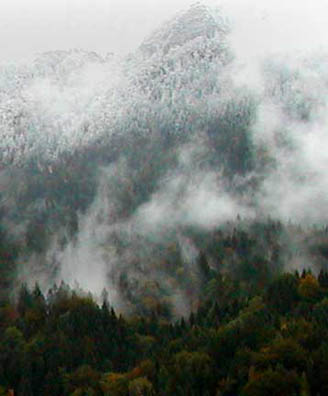 salad with wurst, smaltz, (cheese spread), cheese, rye bread, and bretzels. It was all wonderful and of course we ate more than we should. Naturally, all of this was washed down with large glasses of cold beer. Then the fresh pears and grapes were brought in from the garden! Of course, about then we somehow got on the subject of Limoncello, so they shared some of their homemade Limoncello (it was excellent). They actually had made it in Sicily from fresh lemons when they were there earlier this year. Well, we couldn’t have asked for a more perfect evening - good company, good food, and good times. Our many thanks to Dieter and Irene for a taste of Bavaria! salad with wurst, smaltz, (cheese spread), cheese, rye bread, and bretzels. It was all wonderful and of course we ate more than we should. Naturally, all of this was washed down with large glasses of cold beer. Then the fresh pears and grapes were brought in from the garden! Of course, about then we somehow got on the subject of Limoncello, so they shared some of their homemade Limoncello (it was excellent). They actually had made it in Sicily from fresh lemons when they were there earlier this year. Well, we couldn’t have asked for a more perfect evening - good company, good food, and good times. Our many thanks to Dieter and Irene for a taste of Bavaria!
That evening it turned very cold (about zero Celcius) and the next day when we were in Berchtesgaden the clouds lifted for a bit and we got this brief glimpse of the first snowfall of the season (left).
|

 To get to Mittenwald, we traveled by Lake Constance, then took the ferry across the Bodensee, over the hills into Garmisch-Partenkirchen (home of the winter Olympics 1936). This is about as far as most Americans go as it is only about 100 kilometers from Munich. But of course, we didn’t come via Munich, we came through the mountains and enjoyed the wonderful roads with the other hundred or so bikers on a sunny Sunday afternoon. Naturally we were rewarded by the most gorgeous scenery one could imagine. Everywhere we turned there were luscious green valleys with a backdrop of mountains. Above is a view from one of the mountain passes.
To get to Mittenwald, we traveled by Lake Constance, then took the ferry across the Bodensee, over the hills into Garmisch-Partenkirchen (home of the winter Olympics 1936). This is about as far as most Americans go as it is only about 100 kilometers from Munich. But of course, we didn’t come via Munich, we came through the mountains and enjoyed the wonderful roads with the other hundred or so bikers on a sunny Sunday afternoon. Naturally we were rewarded by the most gorgeous scenery one could imagine. Everywhere we turned there were luscious green valleys with a backdrop of mountains. Above is a view from one of the mountain passes. 
 Mittenwald is another 20 km past Garmisch, also nestled at the base of the Alps, but much smaller, quieter, and less metropolitan. This is a town where the Germans go for holiday, as a base for sightseeing or hiking in the surrounding mountains. It is town full of beautifully painted buildings, each its own work of art (we just kept marveling at the cost for repainting!). At left is a view of the center of town, with the church tower at the center. At the right is the bank, in all its glorious detail. Not all the buildings are completely decorated as these, but most have at least a mural or decorated window frames.
Mittenwald is another 20 km past Garmisch, also nestled at the base of the Alps, but much smaller, quieter, and less metropolitan. This is a town where the Germans go for holiday, as a base for sightseeing or hiking in the surrounding mountains. It is town full of beautifully painted buildings, each its own work of art (we just kept marveling at the cost for repainting!). At left is a view of the center of town, with the church tower at the center. At the right is the bank, in all its glorious detail. Not all the buildings are completely decorated as these, but most have at least a mural or decorated window frames. eep you out. We found at least one visitor was enjoying the water and did not want to get out!
eep you out. We found at least one visitor was enjoying the water and did not want to get out! In the neighborhoods, we enjoyed the traditional architecture with lots of decorative wood in the shutters, balconies and eaves. Of course every window box and balcony was a billowing mass of brightly blooming geraniums and petunias, adding splashes of color to the pristine setting. One architectural oddity we noticed were the old-fashioned rain gutters that extended from 6 to 10 feet away from the buildings. Pictured at right is a series of them in town on a row of line houses. The pavement below is asphalt, except under the ends of the spouts where granite stones have been laid to take the brunt of the force from the falling water. This was certainly one way to divert the water away from the houses!
In the neighborhoods, we enjoyed the traditional architecture with lots of decorative wood in the shutters, balconies and eaves. Of course every window box and balcony was a billowing mass of brightly blooming geraniums and petunias, adding splashes of color to the pristine setting. One architectural oddity we noticed were the old-fashioned rain gutters that extended from 6 to 10 feet away from the buildings. Pictured at right is a series of them in town on a row of line houses. The pavement below is asphalt, except under the ends of the spouts where granite stones have been laid to take the brunt of the force from the falling water. This was certainly one way to divert the water away from the houses! The town of Mittenwald lies in a valley with mountains to the east and the Alps to the west (the valley itself is at about 3500 feet). At left is a view of the Alps rising majestically above the local houses (the highest peak is 2628 meters). There is a cable car that will take you to the top if you desire, though we did not ride up. For the really adventurous sorts, you can ride up and hike down (or ski down in the winter). Although the town was nearly full of visitors in August when we were there, we are sure it is holiday haven in the winter ski season.
The town of Mittenwald lies in a valley with mountains to the east and the Alps to the west (the valley itself is at about 3500 feet). At left is a view of the Alps rising majestically above the local houses (the highest peak is 2628 meters). There is a cable car that will take you to the top if you desire, though we did not ride up. For the really adventurous sorts, you can ride up and hike down (or ski down in the winter). Although the town was nearly full of visitors in August when we were there, we are sure it is holiday haven in the winter ski season. The Austrian border is just northeast of Mittenwald, and a short drive over the mountain will take you to the valley of Leutach. The valley is dotted with small villages full of guesthouses and really comes alive in the winter as the area is great for cross-country skiing. There is also one downhill area for those with a need for speed. In the village of Weisbach is a great little restaurant we were told had the best food in the world. While we can’t vouch for that (we haven’t yet tried everywhere in the world!), we can tell you that the pea soup and the garlic cream soup were fantastic and the trout menuire and the lake trout fillet were absolutely divine. Everything was fresh, wonderfully prepared, and artfully presented. But we’ll have to go back to try their desserts as we left no room for them. The restaurant is named Pichler and is pictured at right.
The Austrian border is just northeast of Mittenwald, and a short drive over the mountain will take you to the valley of Leutach. The valley is dotted with small villages full of guesthouses and really comes alive in the winter as the area is great for cross-country skiing. There is also one downhill area for those with a need for speed. In the village of Weisbach is a great little restaurant we were told had the best food in the world. While we can’t vouch for that (we haven’t yet tried everywhere in the world!), we can tell you that the pea soup and the garlic cream soup were fantastic and the trout menuire and the lake trout fillet were absolutely divine. Everything was fresh, wonderfully prepared, and artfully presented. But we’ll have to go back to try their desserts as we left no room for them. The restaurant is named Pichler and is pictured at right. We returned to Bavaria in September, 2002 to visit Munich and and surrounding areas with our friend Nancy Haynes. The day we got to the Munich area, the weather was nice so we took the opportunity to drive to Obersalzberg to visit the Eagle’s Nest (left). It was a good thing we did so as we never had another clear day like this while we were there. An American couple provides excellent tours of the Obersalzberg and all the Nazi history associated with it. We were first driven around the area and shown where all the houses and building were (a few still exist while the others were destroyed by bombing).
We returned to Bavaria in September, 2002 to visit Munich and and surrounding areas with our friend Nancy Haynes. The day we got to the Munich area, the weather was nice so we took the opportunity to drive to Obersalzberg to visit the Eagle’s Nest (left). It was a good thing we did so as we never had another clear day like this while we were there. An American couple provides excellent tours of the Obersalzberg and all the Nazi history associated with it. We were first driven around the area and shown where all the houses and building were (a few still exist while the others were destroyed by bombing).  W e the n got a tou r of a section of the 6 km of tunnels built under these hills as a safe place of retreat, should it be needed (although they had living quarters in them, they never stayed there for any long period). A map of the tunnel network is shown at right, depicting the tunnels as well as their connection to the buildings above [in dotted lines]). It was interesting to note that there is a smaller section of tunnels at the top not connected to the lower, larger section. The smaller section was connected to Goering’s residence; Borman was in charge of the building of the tunnels and as he did not like or trust Goering, Borman never made the connection so that Goering would not have access to Hitler. Interesting dynamics within the Third Reich.
W e the n got a tou r of a section of the 6 km of tunnels built under these hills as a safe place of retreat, should it be needed (although they had living quarters in them, they never stayed there for any long period). A map of the tunnel network is shown at right, depicting the tunnels as well as their connection to the buildings above [in dotted lines]). It was interesting to note that there is a smaller section of tunnels at the top not connected to the lower, larger section. The smaller section was connected to Goering’s residence; Borman was in charge of the building of the tunnels and as he did not like or trust Goering, Borman never made the connection so that Goering would not have access to Hitler. Interesting dynamics within the Third Reich. We visited the town of Berchtesgaden, near the Obersalzberg, enjoying a trip to the Salzbergwerk Berchtesgaden. This salt mine has been in operation since 1517 and continues to operate today. Most of the salt is extracted by brine. A deep shaft is drilled then the lower portion filled with fresh water. The salt dissolves, leaving a rocky residue in a now larger hole. The water at the top is removed - a brine containing the disolved salt. More water is added and salt continues to dissolve from the until the cavern is quite large in diameter. The resulting hole is continuously filled to the top and salt is leached from the ceiling. A huge cavern like this will supply brine for up to 30 years. On the tour, we were floated across one of the resulting lakes no longer being used for production.
We visited the town of Berchtesgaden, near the Obersalzberg, enjoying a trip to the Salzbergwerk Berchtesgaden. This salt mine has been in operation since 1517 and continues to operate today. Most of the salt is extracted by brine. A deep shaft is drilled then the lower portion filled with fresh water. The salt dissolves, leaving a rocky residue in a now larger hole. The water at the top is removed - a brine containing the disolved salt. More water is added and salt continues to dissolve from the until the cavern is quite large in diameter. The resulting hole is continuously filled to the top and salt is leached from the ceiling. A huge cavern like this will supply brine for up to 30 years. On the tour, we were floated across one of the resulting lakes no longer being used for production. protective miner’s clothin g) as they take the plunge down the slide. Hey Verna, your fly is open!
protective miner’s clothin g) as they take the plunge down the slide. Hey Verna, your fly is open!
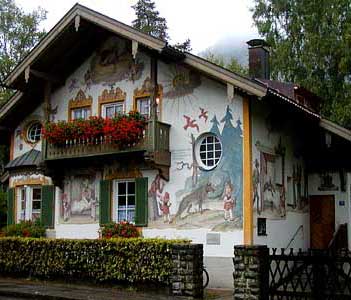
 Between Munich and Berchtesgaden is Chiemsee Lake where Mad King Ludwig built yet another of his unfinished castles. This one, Herrenchiemsee, was modeled after Versailles and the King did his best to increase the grandeur and opulence, even if the overall size is smaller. Only 20 of the rooms were finished and there were no plans for the other 50 rooms, so they remained unfinished. He had only spent 9 days here before his untimely death, so even the finished rooms were never really lived in or used. The palace opened to the public shortly after his death in an attempt to regain some of the money spent on the palace (more than New Schwanstein and Linderhof combined). The view from the gardens is at left.
Between Munich and Berchtesgaden is Chiemsee Lake where Mad King Ludwig built yet another of his unfinished castles. This one, Herrenchiemsee, was modeled after Versailles and the King did his best to increase the grandeur and opulence, even if the overall size is smaller. Only 20 of the rooms were finished and there were no plans for the other 50 rooms, so they remained unfinished. He had only spent 9 days here before his untimely death, so even the finished rooms were never really lived in or used. The palace opened to the public shortly after his death in an attempt to regain some of the money spent on the palace (more than New Schwanstein and Linderhof combined). The view from the gardens is at left. Returning from Herrenchiemsee, we took a slight detour to pass through the little town of Neubeuern, whose old town center was faithfully rebuilt after 2 disastrous fires in the late 1800s. The houses, church and town gates are covered with trompe-l’oeil paintings and the castle (built in the local historical style in 1904-08) sits on the hill above, overlooking the town. The old town is quite small, only a couple of blocks long, with a town gate at either end, each small enough to keep out the large tourist busses. One of the houses covered with paintings and embellished with geraniums appears at right.
Returning from Herrenchiemsee, we took a slight detour to pass through the little town of Neubeuern, whose old town center was faithfully rebuilt after 2 disastrous fires in the late 1800s. The houses, church and town gates are covered with trompe-l’oeil paintings and the castle (built in the local historical style in 1904-08) sits on the hill above, overlooking the town. The old town is quite small, only a couple of blocks long, with a town gate at either end, each small enough to keep out the large tourist busses. One of the houses covered with paintings and embellished with geraniums appears at right. salad with wurst, smaltz, (cheese spread), cheese, rye bread, and bretzels. It was all wonderful and of course we ate more than we should. Naturally, all of this was washed down with large glasses of cold beer. Then the fresh pears and grapes were brought in from the garden! Of course, about then we somehow got on the subject of Limoncello, so they shared some of their homemade Limoncello (it was excellent). They actually had made it in Sicily from fresh lemons when they were there earlier this year. Well, we couldn’t have asked for a more perfect evening - good company, good food, and good times. Our many thanks to Dieter and Irene for a taste of Bavaria!
salad with wurst, smaltz, (cheese spread), cheese, rye bread, and bretzels. It was all wonderful and of course we ate more than we should. Naturally, all of this was washed down with large glasses of cold beer. Then the fresh pears and grapes were brought in from the garden! Of course, about then we somehow got on the subject of Limoncello, so they shared some of their homemade Limoncello (it was excellent). They actually had made it in Sicily from fresh lemons when they were there earlier this year. Well, we couldn’t have asked for a more perfect evening - good company, good food, and good times. Our many thanks to Dieter and Irene for a taste of Bavaria!